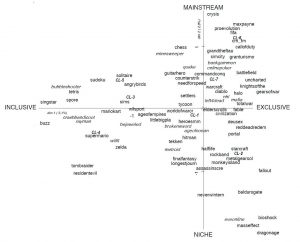From fans of FIFA to those who enjoy The Sims, there is plenty to analyze about gaming preferences.
In their article “The Structure of Video Game Preference”, Rune Klevjer and Jan Fredrik Hovden study the statistical patterns of video game preferences, They place emphasis on the established “inclusive” versus “exclusive” gaming, as well as mainstream versus “niche”. They also also found different groupings that players can be sorted into based on their gaming preferences.
Methods and participants
The article is based on two surveys of Norweigian higher education students’ culture, media and lifestyle preferences conducted between 2008 and 2010. In the survey, the participants were asked (among other things) to name up to three favorite video game titles and how often they play video games. From the 2367 respondents of the study, 758 mentioned at least one favorite game, resulting in a total of 538 different titles mentioned.
Using the Multiple Correspondence Analysis , Klevjer and Hovden managed to identify “patterns of association and opposition” based on the favorites stated by the participants. For example, if a participant named Mass Effect (the study listed all games of the same series under a single entry) as their favorite, how likely it was for that person to also mention Sims as well?
Results
Klevjar and Hovden state that the most dominant dimension of opposition they found was the one between an inclusive and family-friendly orientation at one end of the spectrum and an exclusive, high-tech and dark/mature at the other. Another major dimension was mainstream versus niche. With these two dimensions, Klevjar and Hovden created a figure showcasing the “space of video game series”.
“The Space of video game series”. Picture taken from the article.
In the picture, titles placed closer together were more likely to be mentioned together. For example, Super Mario is more likely to be mentioned together with The Legend of Zelda than with Gears of War. Titles close to the center (like Elder Scrolls) have less clearer profiles. This means that while mentioning Super Mario as a favorite indicates a particular taste in gaming, stating titles like Elder Scrolls does not. The left-right axis of the picture shows an opposition between inclusive and exclusive appeal. Most of the games on the left are family friendly and easy to pick. The games on the right tend to be more violent (with the exception of sports games) and time demanding. There are exceptions, of course: Super Mario titles are quite time demanding and require effort. There is also a strong gender differences present here: women seem to favor the games on the left, while men prefer the games on the right.
The vertical axis shows another dimension of opposition. The lower half of the axis is dominated by role-playing games, while the upper half contains sports and action-adventure games. The division between the “geeky” niche games and mainstream games seems to be quite clear. In this context, Klevjar and Hovden define niche as “relative specificity and uniqueness of a game’s thematic appeal and/or gameplay characteristics in comparison to other media, including traditional games. In this sense, The Legend of Zelda and Starcraft are more niche than Solitaire and FIFA”.
With their analysis, Klevjar and Hovden identified seven gamer clusters in the respondents who play video games:
Strategists: People who favor series like Civilization and The Sims. They are located close to the center of the axis.
Casuals: Located in the top left corner of the axis. These players favor games that are easy to pick up and not too complex, like Angry Birds.
Nintendos: As the name suggests, these gamers favor Nintendo games. Bottom left of the axis.
Partygamers: The smallest cluster in the sample, prefer social party games like Guitar Hero and Singstar.
“Lads”: The most clearly defined cluster of the sample. Located in the top right of the axis, favor FIFA and Call of Duty. Name comes from the fact that only 4% of people in this group are women. Klevjar and Hovden also suggest that Lads are not necessarily very much into video games. They like action and football in general, and that is the reason they play FIFA and CoD.
Roleplayers: A preference for for role-playing games and other large, complex single-player games. Lower right of the axis. Their mentioned titles have a large spread, and there is a lot of overlapping with other clusters.
E-sporters: Favor online and competitive gaming, like Counter-Strike. Klevjar and Hovden mention that if the study would be conducted again, we would probably see titles like League of Legends and DotA in this cluster.
Klevjar and Hovden conclude that the primary dimension of taste differences is the inclusive-exclusive axis, but the niche versus mainstream axis is also important. This vertical axis adds depth to the analysis of preferences. Gender also seems to be a factor in video game preferences, even to the extent if a person plays or not: most of the respondents who claimed not to play video games were females.
Key Information:
Original Article: The Structure of Video Game Preference
Authors: Rune Klevjer and Jan Fredrik Hovden
Published: Game Studies, volume 17, issue 2, December 2017
Original article accessible from http://gamestudies.org/1702/articles/klevjer_hovden
You might also like
More from Game Research Highlights
How do you want to do this? – A look into the therapeutic uses of role-playing games
Can playing RPGs contribute positively to your wellbeing? A recent study aims to find out how RPGs are being used …
Eldritch horrors and tentacles – Defining what “Lovecraftian” is in games
H.P. Lovecrafts legacy lives today in the shared world of Cthulhu Mythos and its iconic monsters. Prema Arasu defines the …
Are Souls Games the Contemporary Myths?
Dom Ford’s Approaching FromSoftware’s Souls Games as Myth reveals the Souls series as a modern mythology where gods fall, desires …
















